From time to time a game appears that revolutionizes and makes itself the standard for a gaming genre. The monthly poll of SpaceSector.com was clear about this for space strategy games. With 33% of the votes (27 of 83), not surprisingly, the favorite space strategy game of all time is: Master of Orion 2. With Master of Orion original game taking the second place with 9 votes (the other options were: SMAC: 9 votes, GalCiv2 and Sins: 8, Imperium Galactica: 6, One of the X-COM series: 5, One of the Homeworld series: 3, One of the SE Series and StarTrek BOTF: 2, Other: 3 votes, Not into Space Strategy: 1 vote, StarWars Rebellion and SOTS got both 0 votes).
Released in 1996 by Microprose, Master of Orion 2 Battle at Antares is undoubtedly considered the reference for 4x space strategy games. But what made this game so popular that after 13 years of game design innovation, better computer resources and way better available graphics no space strategy game seems to be able to surpass MOO2 success? It is true that the game represents a generation of gamers in a time where these games were a rare commodity. Nostalgia surely helps explain a bit the vote intention, nevertheless I think its important to examine the game thoroughly to try to reveal its formula to success.
The Story is simple yet compelling
MOO2 back-story presents a race called Antarans that were imprisoned by the Orions race (here the connection is made to the original Master of Orion game) in a long war that devastated most of the galaxy. The Antarans found (somehow) a way to escape imprisonment and immediately started a terror campaign against all races in the galaxy. With time the Antaran attacks become more frequent and violent and the races will need to decide if they continue to fight each other or if they put an end to this threat.

To stop their menace a race needs to find “a way” to get to the Antarans homeworld (Antares) and stop them once and for all. The race that is able to do this first wins. So it is literally Master of Orion: Battle at Antares.
The User Interface is clean and cohesive
All there is to the game fits in one screen. This is undeniably one of the game’s great assets. In so many games, since MOO2, you get not so streamlined menus that connect to sub-menus in not so much intuitive ways. It’s not hard to get confused or lost in some of today’s game user interfaces. In MOO2 the player has full control of its empire from a single screen, the sub-menus have a total depth of N-2.

In opposition to today’s great visual 3D effects, everything in MOO2 is 2D. Ok so the stars don’t shine, you cannot rotate the galaxy nor zoom-in or zoom-out but MOO2 does offer enough star and planet interactivity to keep the player happy by providing a simple to manage star map and a closeup screen, after clicking on a star, that summarizes the planets present on a given system in a very slick way.
The Colony Management screen is user-friendly, concise and sufficiently informative
One of the greatest leaps of MOO2 from its original Master of Orion game predecessor was the introduction of the planet micromanagement screen. In the original Master of Orion game all the planet management was extremely simple, basically all the player could do was to change the ship building/production/research/waste sliders (in a direct function to planet population and quality) to manage a colony output (pretty much like in Sword of the Stars, a recent 4x game).
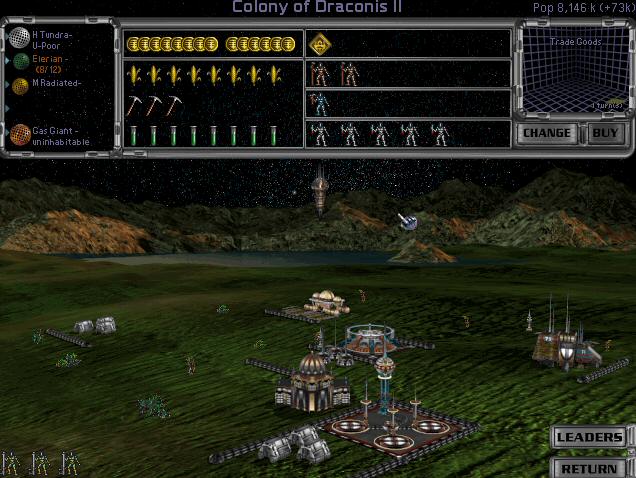
In MOO2 the player is allowed to build structures, and these have a direct effect on the colony (and overall empire) economy, production capability, research output, population bonuses, military buildings, planetary defenses, terraforming, etc.
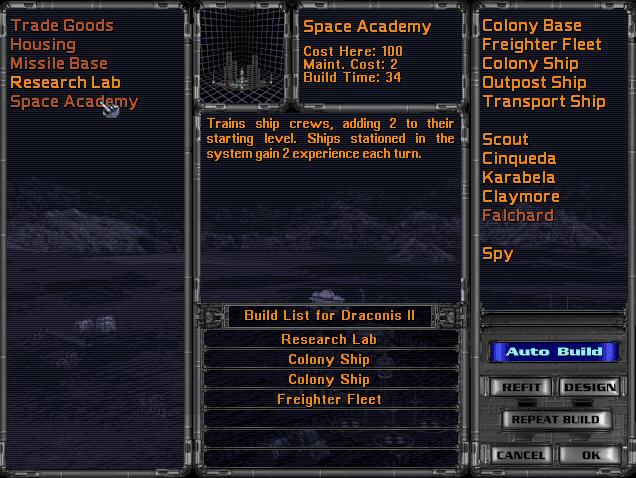
The introduction of this level of planet micromanagement brought a new flavour to the Orion gaming experience. The player has now a much richer experience and relationship with the planets as he can decide to specialize colonies to be research centers, industry plants or commerce/tax farms. With this level of micromanagement the player has the opportunity to see their planets slowly grow which is nice since this establishes an emotional bond between the player and the game as also provides the player with more refined control on what should be built.
The Economy system is simple and intuitive
As can be seen in the colony screen picture above the player can allocate the planet’s population to one of three main fields of the game economy: food production, industry output and research. For every million colonists there is one unit that can be allocated to one of these three economy items. Without food the planet population will starve to death, so to maintain a planet above starvation level some of its inhabitants must be allocated to farming business. The rest of the population can be allocated to industry output which can be converted into spaceship and buildings production, or to research that will generate research points required to unlock new technologies. The economy sounds simple and is indeed. To note that all the industry and food produced in the planet is entirely diverted to that planet itself in contrast with [edit] food, [/edit] research points and money produced by taxes and trade, these two three resources sum up to the overall empire stock. [edit] Note: Excess food is transported to starving planets by freighters. [/edit]
MOO2 has no overall production/research empire sliders (like in Galactic Civilizations games), so you must manage each planet production individually which provides the player a lot of control (although also a few headaches as well – further explained below).
Space Combat is streamlined and enables the player to have full control (if desired)
If the player chooses the “tactical combat” option during game setup the space combat experience is completely tactical, which means that the player has full control on all its spaceships moves in a turn based fashion. All ships are ordered to attack and/or move in a one by one basis and the player is also allowed to choose individual weapons of each ship alone, attacking multiple targets if required.
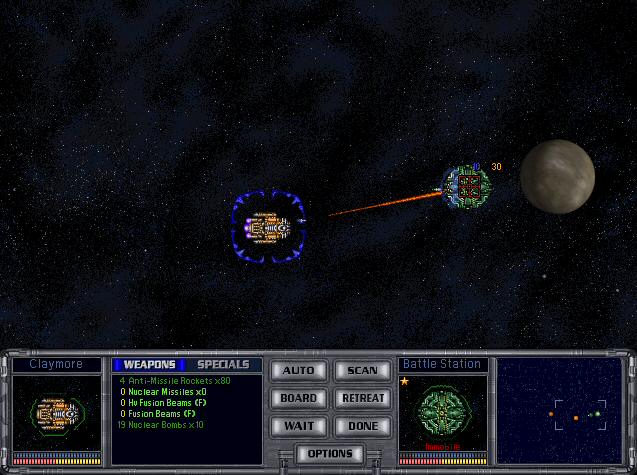
The information presented onscreen is detailed without being too overwhelming. The graphics are basic but quite pretty. The options provided are sufficient.
Ground combat is basic (as it should be) but still fun and scoped
In contrast with spaceship combat, planetary invasions are not tactical. The invasion outcome is auto resolved in a direct relation of ground troop number, technology rank and available equipment. The more troops you bring with better guns the better are the chances you will win the day. I think this is a very good approach for this kind of games since the gaming experience is really about colony management, spaceship design, spaceship combat and research rather than ground assault.
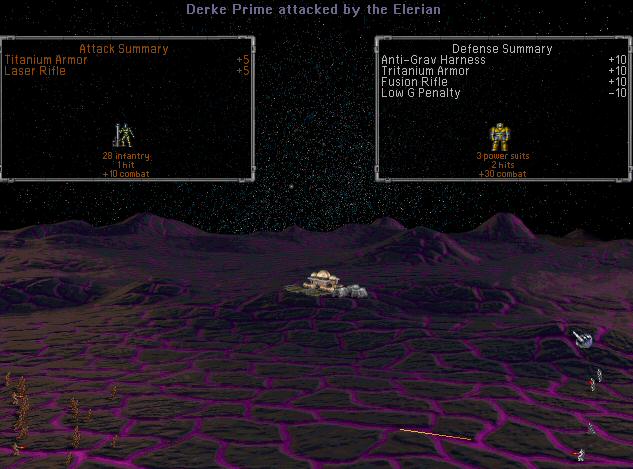
I find the MOO2 invasion mechanics quite simple but elegant giving the player a glimpse of its invasion outcome without turning it into a complex and off-scoped experience. After all it is just a planetary invasion, a minimum degree of atmosphere is required to give the player a sense of accomplishment but no more.
In-orbit space ships can bombard enemy colonies
One interesting aspect of planetary invasion in MOO2 is the option to bombard a planet. Many games in the past completely forgot about the usefulness of fleets in planetary invasion: therefore the bombard feature is a big plus for MOO2. If the player did not forget to bring troop transports he is allowed to invade a planet but before he does that all the planetary outer defenses, which includes any fleet defenses and starbases, must be defeated first. In a next stage the player is offered the possibility to invade the planet with his ground troops. If the player forgot or just does not have at hand troop transports he simply can order the bombardment of the planet (like a siege) to harass the planet colony for some turns or to destroy it completely, as the player decides.
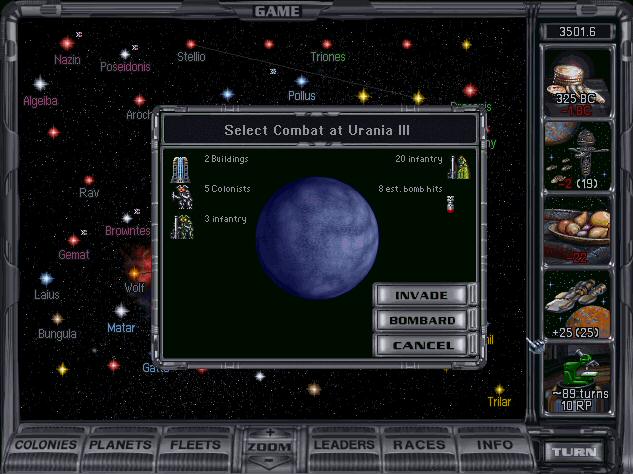
Nothing can be more frustrating than having a full fleet of dreadnoughts orbiting a planet and not being offered the possibility to use all that firepower to some good use and just have fleets around doing nothing just because you forgot to bring some troop transports. Not in MOO2.
The spaceship design screen is user-friendly, intuitive and flexible
The MOO2 spaceship design concept is very simple and flexible. The player can choose one of the 6 types of hulls offered (Frigate to Doom Star) and is able to fully specialize its fleet. The bigger the ship the more it can carry, the more damage it can inflict and take on and the more it costs.
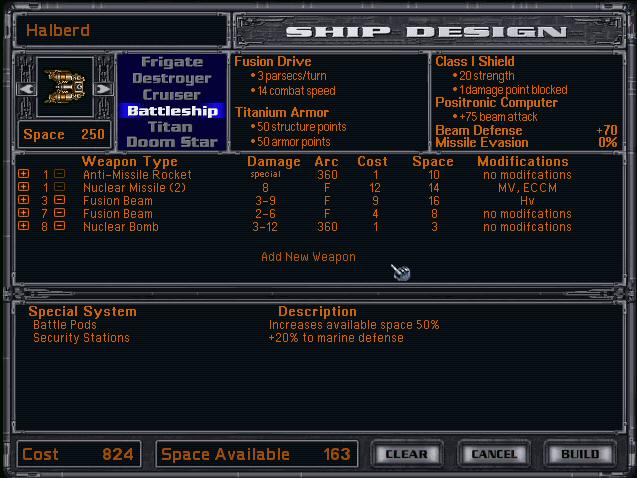
In contrast with other recent space strategy games, [edit] most of the spaceship’s hulls don’t need to be researched (like in GalCiv2 where most need) [\end] nor need to be confined to special types of hulls/missions (like in Sword of the Stars). MOO2 provides full design flexibility which provides another level of micromanagement to the player.
Races are charismatic. Customization really makes a difference and enables game re-playability
MOO2 provides 13 core races and the ability to fully customize a race. Many traits can be tweaked to the player flavor. The number of special abilities are enough to provide sufficient game re-playability with substantial gaming experience variety.
For instance if a player decides to be “creative” (one of the most expensive special abilities), all the potential research technologies (normally 1 to 3) can be learned at once (this is the special core ability of the Psilons race). This gives a significant advantage on technology capability to that race. However this trait is expensive (8 points as can be seen below).
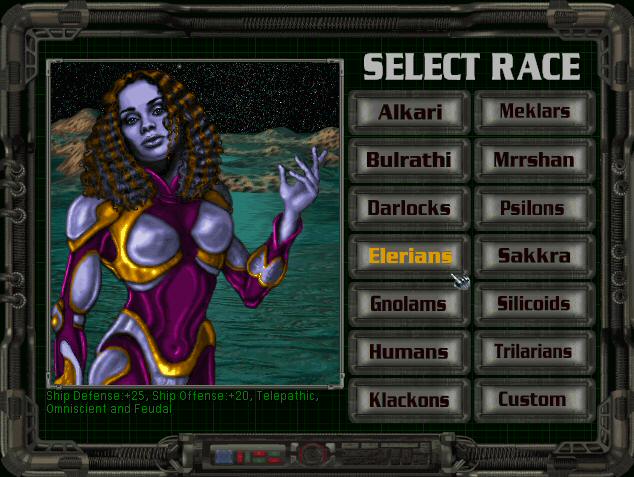
If the player decides for the “Tolerant” trait (the most expensive trait of them all: 10 points) the player is able to colonize all kinds of planets without the need to research the technology normally required to do that. does not suffer production losses due to pollution, and the planets can hold more people. This is a huge advantage for a race for obvious reasons since when in the eXpansion phase this race may be unbeatable. The silicoids race has this trait built-in.
If however the player decides for the Lithovore (one of the most original traits, also the most expensive as Tolerant: 10 points) the player race does not need to “eat”, basically does not need to allocate resources for food production and obviously can reallocate these normally necessary resources to industry or research.
Remark: The silicoid race is both Tolerant and Lithovore which makes them one of the most ferocious races in early stages, if not stopped early they can become overwhelming in numbers and unbeatable at later game stages.
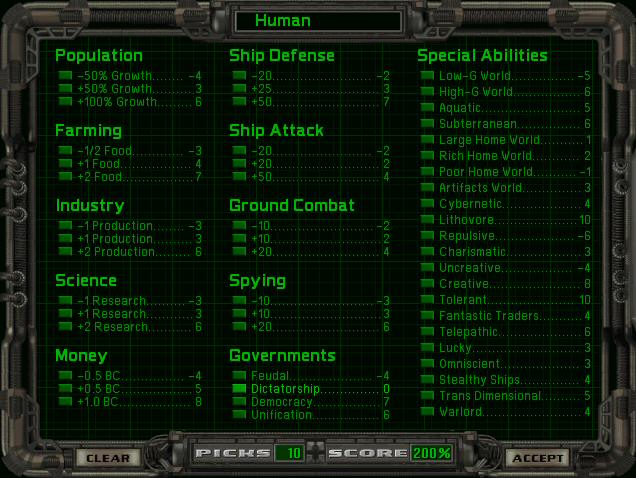
Of course that being Lithovore and Tolerant is very nice however the player needs to think twice before choosing these traits since a lot of compromises need to be done due to these two traits high-cost. You will probably need to be repulsive, uncreative and/or low-G race for example just to be able to choose those 2 very interesting traits.
What makes the MOO2 race customization so brilliant is its option variety, imagination and balanced trait trade-off points scheme. It’s fascinating because the player can actually experience quite different gaming experiences just by choosing one or two different special abilities which favors a lot for game re-playability.
Diplomacy options are effective and stick to the point
The MOO2 diplomacy options are straightforward but quite effective. When proposing a treaty to a race this can be one of Trade, Research, Peace, Non-Aggression and Alliance, how more straightforward can it be. The player can make demands, make offers, exchange techs, declare war or surrender.
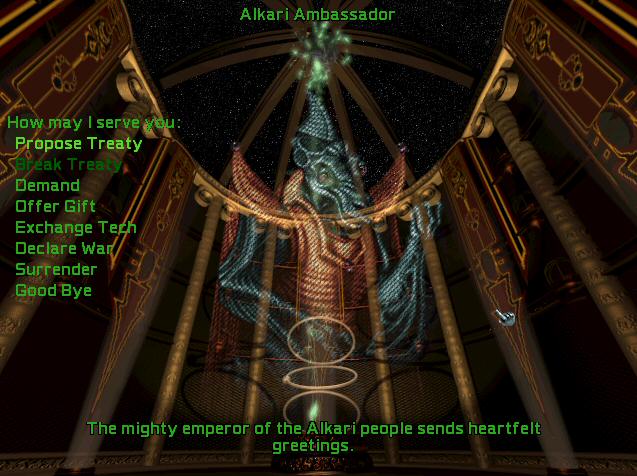
The strong point in MOO2 diplomacy options reside in the menu simplicity, the relevance of the options provided and the ease on using these options in a very concise way. Consider the diplomacy options of Sword of the Stars game for example, how more confusing can a diplomacy menu dialog be than that? It’s ok to be able to provide a lot of diplomacy options to the player but it’s not ok to provide a rather complex, non-intuitive and confusing user interface when delivering all those diplomacy options.
Research concept is solid with sufficient depth and variety
The MOO2 research concept is quite dissimilar from its predecessor. In MOO1 the technology tree was dynamic in the sense that the research could get random at times. After researching Shields IV the player could be able to research Shields VI but not V. In MOO2 the random effect was abandoned in favor of a concept built on top of the creative and uncreative race traits.

As I have already explained above, in the race customization topic, being creative allows the player to unlock all 2 to 3 technologies under a designated research field. Lets take Ion Fission Power above as an example. If the player neither has the creative trait nor is uncreative it is allowed to pick which technology is to be researched. In this example the player choice was to research Ion Drive. By making this decision the player will skip Ion Pulse Cannon and Shield Capacitors in favor of Ion Drive. If the player is in the other hand “uncreative” it will not be allowed to pick the tech from a set of 2 or 3 but a random technology will be unlocked for him. If the player is “creative” it will get all 2 to 3 technologies when researching a particular field.
As you see just by this trait choice alone (creative/uncreative), and the need to make a choice between potential technologies to research from (when the player is neither creative or uncreative), the player is already being given a lot of strategic options which is a great plus for the MOO2 research concept.
Spaceships have leaders, and so have planets
One very interesting concept of MOO2, that was recently mysteriously abandoned by all space strategy games I’ve played since then, is the Leaders concept. The Leaders are special people, Diplomats, Administrators, Experienced Captains, Helmsman, etc, that can be hired by the empire to enhance certain traits. For instance an experienced Helmsman can provide a significant defense bonus to a particular spaceship, a diplomat leader, as represented in the picture below, can provide a bonus to the diplomacy trait.
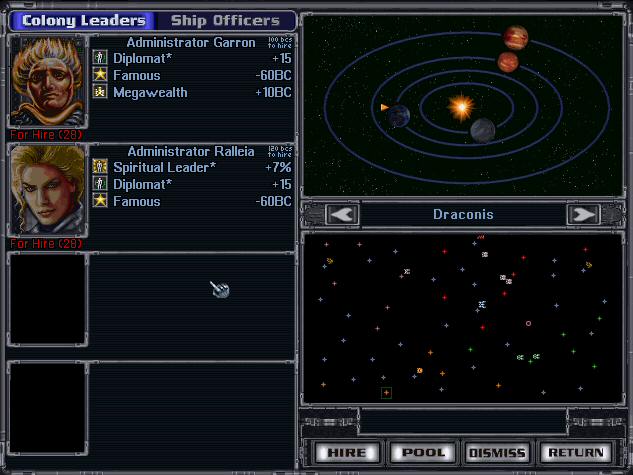
I don’t present here all the classes of Leaders because they were a lot of them, but I give you some examples:
- Environmentalist: Decreases the pollution level of all colonies
- Farming Leader: Increases the food grown by farmers
- Instructor: Increases the amount of experience per turn gained by all leaders and ships
- Science Leader: Increases the research that scientists can produce in a system
- Financial Leader: Increases each colony income by a percent
- Assassin: Has a chance of assassinating an enemy spy
- Commando: Increases the Ground Combat strength of all troops in the system
- Famous: Increases the chance of leaders wanting to join and decreases their hiring cost
- Trader: Increases the income earned from trade agreements
- Engineer: Increases the restoration rate of the ship’s shields and overall damage repair in
combat - Fighter Pilot: Increases the defense and beam weapon damage of all fighter craft used by the
leader’s fleet. - Weaponry: Increases the Ship’s Attack (of the ship assigned)
You may ask, as I do, why was the Leaders concept abandoned by recent games? I don’t have a clue why, this was certainly one of the best and most interesting features of MOO2. This concept must be brought back.
As everything in life MOO2 does have its flaws
Sometimes space combat can become a very tedious process. If the player decides to get tactical he must assign all ships one by one (and there can be many of them) in a very tedious point-and-click endless process that can take many minutes in later game stages. The game does offer an auto-play feature, however even with that the process can still be quite tedious as big battles require a huge number of turns to finish. To overcome this flaw Microprose released a MOO2 patch (v1.3.1) that somehow softened this problem by introducing a super-quick auto mode, but even there it still could be monotonous to watch.
The level of micromanagement provided by MOO2 is pointed as being at the same time the best and worst of its features. The player can have full control of its colonies however due to the lack of effective governors that could automate the more tedious tasks the player spends most of its time, during late games, assigning buildings for construction in all its planets one by one turning the gameplay experience in a complete nightmare.
Graphics are obsolete for contemporary standards, however they were (more than) fine at the time.
Conclusion
Master of Orion II is simple, intuitive, user-friendly and fun. These are the principal ingredients for it being one of the most successful games of all times. In recap Master of Orion II provides the following formula to success:
- The Story is simple yet compelling
- The User Interface is clean and cohesive
- The Colony Management screen is user-friendly, concise and sufficiently informative
- The Economy system is simple and intuitive
- Space Combat is streamlined and enables the player to have full control (if desired)
- Ground combat is basic (as it should be) but still fun and scoped
- In-orbit space ships can bombard enemy colonies
- The spaceship design screen is user-friendly, intuitive and flexible
- Races are charismatic. Customization really makes a difference and enables game re-playability
- Diplomacy options are effective and stick to the point
- Research concept is solid with sufficient depth and variety
- Spaceships have leaders, and so have planets
How to play in Windows XP/Vista, MacOS and Linux:
Download the DOSBox DOS operating system emulator. The installation is simple and the games run smoothly, exactly as they did more than 13 years ago.
|
(about the score system) |
|---|
| The Good: – The Story is simple yet compelling; – The User Interface is clean, functional and very user-friendly; – The Spaceship design screen is intuitive and flexible; – Races Customization really makes a difference and enables game re-playability; – Research concept is solid with sufficient depth and variety; – Spaceships have leaders, and so have planets (nice RPG elements). |
| The Bad: – Sometimes space combat can become a very tedious process; – High micromanagement may turn gameplay in a complete nightmare, specially during late games. |
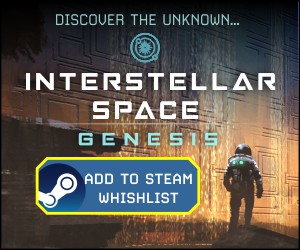
36 Comments
Related Articles:
- Aphelion Phoenix Rising: A new 4x Space Strategy Game under Development
- Beyond Beyaan Preview
- What makes a good 4x space game economy model?
- A New Way to Explore Planets
- FreeOrion: A Free Open Source 4x Space Strategy Game

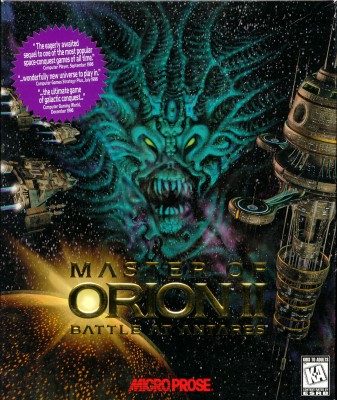
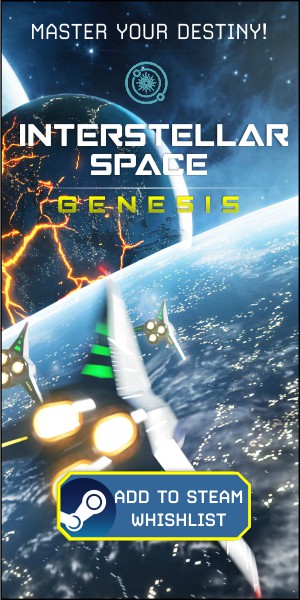
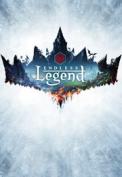

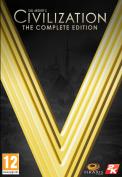


Such memories. Back in the day, this game was my evening’s entertainment…well until sunrise :)
Your points about micromanagement are fair. There is information overload in the later game, its just symptomatic of the genre. In some ways, gaming has ‘moved on’ from this grand strategy games. They still exist, but are no longer the big releases the game community looks forward to. They have been pushed into the niche.
Shame.
One comment: as I recall, you DID have to research some hulls to build them. Particularily the larger ones.
You’re completely right, thanks for the comment Rasputin! Titan and Doom Star classes do need to be researched in later stages. Fixed.
A great blast from the past – you captured my sentiments entirely.
ty
Cool site, love the info.
This site rocks!
Good review. Keep up the good work with this website. I like it.
Best,
GJ
> If the player decides for the “Tolerant” trait the player is
> able to colonize all kinds of planets without the need to
> research the technology normally required to do that.
“Tolerant” removes all pollution on your planets.
There are no technolgies required to colonize different kinds of planets (apart from “Artificial Planet” which allows you to create planets from asteroids and gas giants).
> all the industry and food produced in the planet is
> entirely diverted to that planet
Excess food is shipped to starving planets by freighter fleets.
You’re right, Fixed!
Thanks for your comments moo36k :)
I like it.
Thought along those lines when I did a backup recently.
Thanks.
I have never quite understood why developers did not just simply re-release this game with up to date graphics, new graphical interface and expanded story/tech tree. Simple. After that they could use the money from sales to develop the next one i.e. try changing aspects of the formula then. In my opinion, the closest one to the original formula is SEV, but there are aspects of this that I don’t enjoy and pretty much ‘put-up-with’ i.e. 100 different versions of a research lab and I have to tell every colony to update them.
Its just painful to watch game after game come out and either one aspect of it is missing or radically altered and untested (Gal Civ – input into ship battles gone, Swos – colony management & Diplomacy really depleted, Sins – turn based management gone and storyline/theme). I just don’t understand how these are pitched, surely it is obvious that this is what the community is literally crying out for and if they don’t get on it soon some of them will make it themselves!
I know I sound like a winger….. but that’s because I am, I’ve paid my dues and been very patient and therefore think I’m entitled to it. From 1996 till now, buying every game that claimed the 4x title of the next MOO2, and don’t you dare claim that MOO3 was good…….don’t you dare!
“…why developers did not just simply re-release this game with up to date graphics, new graphical interface and expanded story/tech tree. Simple.”
Nope, it’s not simple. Making changes to something that has been “baked” long time ago with archaic technology is no simple task.
MoO 2 used some custom image format that supports palette switching (basically the same image with different colors, like some monsters in Diablo 2) and multiple frames per file. That format is not supported by any modern image editor.
GUI has always been a bitch to code. Modern technology does make things simple for making businesses oriented software but game GUI quite often requires reinventing the wheel. And don’t make me start with juggling between designing (location, size, appearance of the components) and actual coding (behavior of the components). Technology back than was even worse so it can presumed that MoO GUI code is a big unmaintainable mess.
Expanding tech tree might actually be simple presuming there are no hidden gotchas like hardcoded tech counts. I once stumbled upon open source project that tackled issue of reading MoO 2 save game files. There was a piece of code that described how are ship designs stored and there was a curious fact, MoO 2 can’t support more than 32 special equipment techs. Presence of spec. equipment on the ship was marked by a single bit in 32-bit variable (probably int).
IMO rewriting whole code and remaking all assets would be simpler than updating current code and assets.
@Robin
I’m with you, don’t also understand how Master of Orion IV is taking so long to be developed. I’ve read somewhere that could be licensing issues, anyway I agree with you when you say that the community is crying for a MOO sequel. This is so evident that I really don’t get what is holding people to go ahead.
There is the freeorion project, but its taking too looong: https://www.spacesector.com/blog/2009/07/freeorion-a-free-open-source-4x-space-strategy-game/
Brilliant blog posting. I found your post very interesting, I think you are a brilliant writer. I added your blog to my bookmarks and will return in the future.
I sure miss Microprose. The only company that compares today is Blizzard. If they only had someone that could have managed the budget they might still be around.
I still play some of their old games. Transport Tycoon Delux, MOO2, Master of Magic, Colonization, XCOM 1&2….
I really should try MOO2 (CIV2 too but this is not the right forum).
I would never tell that MOO3 was good but not even put it in the products list seems a little harsh… I played it for a while and I really wanted to like it.
In the same vein… what about Final Frontiers, the space mod of CIV IV BTS?
@Paolo
You never played MOO2? By all means please try it. Use the DOS box simulator to play it.
I do have MOO3 in the Games list (as “another game” in MOO2).
I didn’t spent time yet analysing and reviewing Sci-fi mods (e.g. Final Frontiers). But it could be a good idea to explore them!
I already buyed the three MOO on impulse at the same time.
Probably I will give it a try.
The original Master of Orion may seem a bit dry and not fun at first, but give it a try. I remember that I hated the game at first impression, a long time ago … It’s simplicity is genius.
Master of Orion 2 is “the” 4x sci-fi game. It’s incredible how graphics don’t seem that outdated as you could expect. Ship design is brilliant. Research is cool. Combat, although having it’s shortcomings is fun. Well, you know what I think about MOO2 by my review. I don’t know how it feels like to play MOO2 at this time of my life, I’m 33 now. Let me know what were your experiences with it.
Master of Orion 3 was a bummer. But I know of people that really enjoyed playing it, I think after some patches and possibly some mods. Try looking for them.
Have fun ;)
I read part of your article, and saw the part where you said you could also bombard using your fleets, but only after all defenses had been destroyed.
Well, that’s partially true.
In fact, DURING combat, you can also bombard the planet. That is, excess damage, once the planetary defenses have been destroyed, will also have good chances to kill population, troops, or destroy buildings. In fact, if you’re not careful, and launch a doomsday-style hail of missiles, you could very well raze to the ground a planet that you would have liked to conquer.
So, yes, you need to destroy the PLANETARY defenses first (the starbase can still be alive, it doesn’t matter), but you don’t need to destroy all defenses, or even win the fight to do so ^^
Oh, and biological weapons might even work while there are defenses left on the planet… but, of course, the bomber will have to reach the vicinity of the said planet, which could be quite a challenge if the defenses are still active.
I hope it helps.
You’re right, you can in fact bombard while still doing battle.
An unofficial port of the moo2 is being developed in this site (www.orionrebirth.com) it is still in the first stage though.
This is an amazing summary of MOO2 as others have said. I think Tylon’s point is very valid, Microprose was the key ingredient that others have not been able to replicate in the franchise (I think mostly because of Sid Meier’s Genius). I remember some classic Amiga games put out by Microprose like Railroad Tycoon and Silent Service, also groundbreaking games. Adam touches on it in this post, but basically we get so wrapped up in graphics these days that we forget the game-play and I think as long as the graphics don’t take you out of the experience, it’s ok to not have 3D views of your planets and starships and all that fanciness.
Thanks for keeping the love of the 4x space game alive Adam!
-Matt
Thanks Matt. It is done with a lot of love.
Railroad Tycoon is a classic. I agree with you and Tylon that Microprose has something to do with this. They sure knew how to make god damn good games. Sid was part of the blame for sure, if not the most important part. Just look at Microprose’s games list: http://pt.wikipedia.org/wiki/MicroProse
Amazing.
Or people just don’t know how to do good games these days (can’t touch Microprose, Sierra, others, genius) or we we’re simply getting old :) Not sure which but the later is a fact.
Great site. I’ve played all the 4X games you’ve mentioned, and I would still be one of those that voted for MOO 2. I still go back to it for a little R&R. Personally, I don’t see how you can give it “only” an 8.9 rating, when you state yourself that it is the benchmark by which all others are measured! :->
I found it easy to CTRL-Z out of tedious battles and was always so happy to reach the end game that I did not mind the micro-management that came with it!
I agree totally with Robin (above) – Many of us would be happy with a simple update to MOO 2.5 that modernizes the graphics, allows larger galaxies and eliminates some of the micro-management (a lot could be done by just allowing production/research queues to be saved/loaded). And keep the turn-by-turn play as well as the the option of tactical combat. My $49 would be immediately PayPaled over.
I can’t believe it, but I just read a review for another 4X game and the author was so excited that boarding parties were allowed! The wheel has already been invented, let’s just polish it up!
I gave it an 8.9 for the reasons I stated in the review. And, 8.9 is the biggest score I gave to date in my site for a 4X game, besides Sins of a Solar Empire : Trinity of course. But Sins is not a pure 4X (more a light 4X), so, MoO2 indeed has the highest 4X score in Space Sector :)
Let’s keep the standards high. There’s plenty of room for MoO2 improvement.
>>>why was the Leaders concept abandoned by recent games
For the fans of MOO2 who miss the news : Distant Worlds Legends will add Leaders / characters
See the preview from here:
https://www.spacesector.com/blog/2011/10/distant-worlds-legends-preview/
I know this is a bit late, but I just found this review. There’s a part where you says that you can’t zoom in/out in MoO 2’s galaxy. It’s under the first screenshot of the galaxy. If you look at that screenshot, you’ll see that there is “Zoom” in bottom middle of the row of buttons. It’s used to zoom in/out for the galaxy.
The funny thing is that I didn’t know I could zoom in/out until a week ago when I was watching a let’s play for MoO 2, and the player zoomed in. I was like, WHAT? How did I miss that the whole time I’ve been playing it? I know I noticed the zoom button, but I never thought about it, or even actually noticed it. It was just there, as a part of the background or something.
Awesome site, love the dedication to the genre. My first “space game was actually the first EV game for Mac way back in the mid 90’s. I look forward to keeping up with your site as a method of tracking whats new and what I may have overlooked. GREAT WORK!
Thanks! It’s made with love :)
Great review and great site. MOO2 is also one of my all time favourite games. I am sad that there is still no game that comes close to it’s simplicity but addictiveness. I really enjoyed building fleets with the most overpowered doom stars possible (multiple star destroying beams on them with modules that tripled the damage done by them :D) The Antarans used to be tiny insects late in the game ;) Thanks for maintaining such a great site. I enjoyed reading some of your other reviews!
Thanks! I’m pleased you’re having a good time reading. Hope you come back to the site often and comment regularly.
I love your appreciation for MoO2! im with u. Was the best x4 game ever.
In the game can capture an enemy ship approaching it or troop carriers, and then dismantle and have a chance to get some of their technology! that was awesome!
Loved reading this article, you hit the nail on the head. I still remember my first ground invasion. Something about watching those little men run and gun at each other spoke to the kid in me and I was hooked!
I also want to say what an amazing site this is. Up until I discovered this a few days ago I never realized how much the 4x space genre was growing. Now all i need is a good 4x fantasy and I’m forever happy lol. Keep up the excellent coverage, I know I will be visiting VERY often!!
For me you forgot to mention one critical aspect:
The reserch topics are meaningfull!!
In many games I have to reserch Blaster-1 then Blaster-2 (+20%) then Blater-X (+X%) and so one. Booooring!!!
The concept of special items like weapons who kill marines, or tractorbeams who can freeze ships in space, so you can easily board then, or specoal devices who double the damage who penetrates their shields… THIS ist for me one of the outstanding features of the game. You can use synergies between these device AND you have to leave some weapons due to the space requirements for these devices.
And this connect to another great feature: Decicions.
In every really good game I have played you have to made big decicions. You can for example build many small ships and try to rush yout enemy, or you try to research like a maniac to get an ege in technology, or you build unstopable Battleships fist an upgrade them later on, it is up to you.
The UI, the sound, the graphics are really nice. I like the reserch success screen, I like the sound of my weapons and the impact in the enemys shields but other games can support this today easily, but are nevertheless… boooring. :)
regards Yrth
Decisions, decisions,decisions and not one is the same. This game is all about making decisions, how to design a race, which techs to pick, which to miss, to continue with refined old weapon or move on to clumsy but more powerful new one. If only it was open source so people can keep developing it.